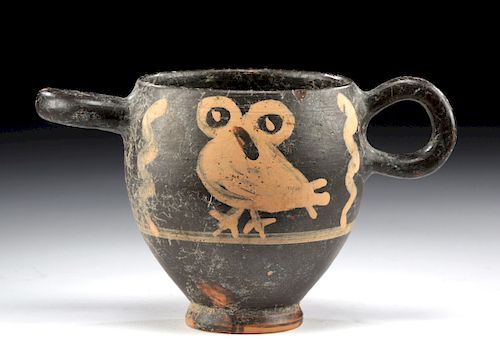Rare Etruscan Applied Red Owl Glaux, ex-Bonhams
Lot 56
About Seller
Artemis Fine Arts
686 S Taylor Ave, Ste 106
Louisville, CO 80027
United States
Selling antiquities, ancient and ethnographic art online since 1993, Artemis Gallery specializes in Classical Antiquities (Egyptian, Greek, Roman, Near Eastern), Asian, Pre-Columbian, African / Tribal / Oceanographic art. Our extensive inventory includes pottery, stone, metal, wood, glass and textil...Read more
Estimate:
$3,500 - $5,500
Absentee vs Live bid
Two ways to bid:
- Leave a max absentee bid and the platform will bid on your behalf up to your maximum bid during the live auction.
- Bid live during the auction and your bids will be submitted real-time to the auctioneer.
Bid Increments
| Price | Bid Increment |
|---|---|
| $0 | $25 |
| $300 | $50 |
| $1,000 | $100 |
| $2,000 | $250 |
| $5,000 | $500 |
| $10,000 | $1,000 |
| $20,000 | $2,500 |
| $50,000 | $5,000 |
| $100,000 | $10,000 |
| $200,000 | $20,000 |
About Auction
By Artemis Fine Arts
Sep 26, 2019
Set Reminder
2019-09-26 10:00:00
2019-09-26 10:00:00
America/New_York
Bidsquare
Bidsquare : Exceptional Day 1: Antiquities & Asian Art
https://www.bidsquare.com/auctions/artemis-gallery/exceptional-day-1-antiquities-asian-art-4437
Day 1 of an important 2-day auction featuring exceptional, museum-worthy examples of Egyptian, Greek, Etruscan, Roman, Viking, Russian, Near Eastern, as well as Asian Art from China, Japan, Thailand, Vietnam, Burma and India. Artemis Fine Arts info@artemisgallery.com
Day 1 of an important 2-day auction featuring exceptional, museum-worthy examples of Egyptian, Greek, Etruscan, Roman, Viking, Russian, Near Eastern, as well as Asian Art from China, Japan, Thailand, Vietnam, Burma and India. Artemis Fine Arts info@artemisgallery.com
- Lot Description
Classical World, Etruria, ca. 350 to 300 BCE. A gorgeous glaux form of skyphos (interestingly, the Greek word for owl is "glaux") of a classic glaux form with one handle oriented horizontally and the other vertically - decorated in added red pigment with an abstract owl flanked by stylized laurel sprigs on each side, all underscored by a red horizontal line. The technique employed for the painted iconographic/decorative program was similar to Six's technique used by Attic black-figure painters. This involved using layers of red or white pigment on the surface and incising details, so that the black glaze shows through. A Dutch scholar by the name of Jan Six first described this technique in 1888, hence the term Six technique. A very special example, as Etruscan owl skyphoi are exceptionally rare, and a wonderful web of root marks imbues the piece with even more charm. Size: 5.875" W x 3.625" H (14.9 cm x 9.2 cm)
Cf. F.P. Johnson, "A Note on Owl-Skyphoi", American Journal of Archaeology, vol. 59, (1955), pp. 119-124., pl. 38, fig, 45.
Provenance: ex New York, New York, USA collection; ex private French collection, acquired between 1930 and 1960; private British collection acquired 1994; ex J.M.E. collection, New York, acquired at Bonham's London October 2009
All items legal to buy/sell under U.S. Statute covering cultural patrimony Code 2600, CHAPTER 14, and are guaranteed to be as described or your money back.
A Certificate of Authenticity will accompany all winning bids.
We ship worldwide and handle all shipping in-house for your convenience.
#149901Excellent save a few chips/nicks to the rim and body. Applied red painted decoration is still strong. Areas of mineral deposits. Covered in a web of root marks!Condition
- Shipping Info
-
All shipping is handled in-house for your convenience. Your invoice from Artemis Gallery will include shipping calculation instructions. If in doubt, please inquire BEFORE bidding for estimated shipping costs for individual items.
-
- Buyer's Premium



 EUR
EUR CAD
CAD AUD
AUD GBP
GBP MXN
MXN HKD
HKD CNY
CNY MYR
MYR SEK
SEK SGD
SGD CHF
CHF THB
THB
















